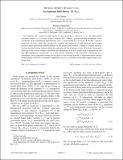| dc.contributor.author | Hohm, Olaf | |
| dc.contributor.author | Samtleben, Henning | |
| dc.date.accessioned | 2014-08-25T12:43:05Z | |
| dc.date.available | 2014-08-25T12:43:05Z | |
| dc.date.issued | 2014-03 | |
| dc.date.submitted | 2013-12 | |
| dc.identifier.issn | 1550-7998 | |
| dc.identifier.issn | 1550-2368 | |
| dc.identifier.uri | http://hdl.handle.net/1721.1/89002 | |
| dc.description.abstract | We introduce the exceptional field theory for the group E[subscript 7(7)], based on a (4+56)-dimensional spacetime subject to a covariant section condition. The “internal” generalized diffeomorphisms of the coordinates in the fundamental representation of E[subscript 7(7)] are governed by a covariant “E-bracket,” which is gauged by 56 vector fields. We construct the complete and unique set of field equations that is gauge invariant under generalized diffeomorphisms in the internal and external coordinates. Among them are featured the non-Abelian twisted self-duality equations for the 56 gauge vectors. We discuss the explicit solutions of the section condition describing the embedding of the full, untruncated 11-dimensional and type IIB supergravity, respectively. As a new feature compared to the previously constructed E[subscript 6(6)] formulation, some components among the 56 gauge vectors descend from the 11-dimensional dual graviton but nevertheless allow for a consistent coupling by virtue of a covariantly constrained compensating 2-form gauge field. | en_US |
| dc.description.sponsorship | United States. Dept. of Energy (Cooperative Research Agreement DE-FG02-05ER41360) | en_US |
| dc.language.iso | en_US | |
| dc.publisher | American Physical Society | en_US |
| dc.relation.isversionof | http://dx.doi.org/10.1103/PhysRevD.89.066017 | en_US |
| dc.rights | Article is made available in accordance with the publisher's policy and may be subject to US copyright law. Please refer to the publisher's site for terms of use. | en_US |
| dc.source | American Physical Society | en_US |
| dc.title | Exceptional field theory. II. E[subscript 7(7)] | en_US |
| dc.type | Article | en_US |
| dc.identifier.citation | Hohm, Olaf, and Henning Samtleben. “Exceptional Field Theory. II. E[subscript 7(7)].” Phys. Rev. D 89, no. 6 (March 2014). © 2014 American Physical Society | en_US |
| dc.contributor.department | Massachusetts Institute of Technology. Center for Theoretical Physics | en_US |
| dc.contributor.department | Massachusetts Institute of Technology. Laboratory for Nuclear Science | en_US |
| dc.contributor.mitauthor | Hohm, Olaf | en_US |
| dc.relation.journal | Physical Review D | en_US |
| dc.eprint.version | Final published version | en_US |
| dc.type.uri | http://purl.org/eprint/type/JournalArticle | en_US |
| eprint.status | http://purl.org/eprint/status/PeerReviewed | en_US |
| dspace.orderedauthors | Hohm, Olaf; Samtleben, Henning | en_US |
| mit.license | PUBLISHER_POLICY | en_US |
| mit.metadata.status | Complete | |
